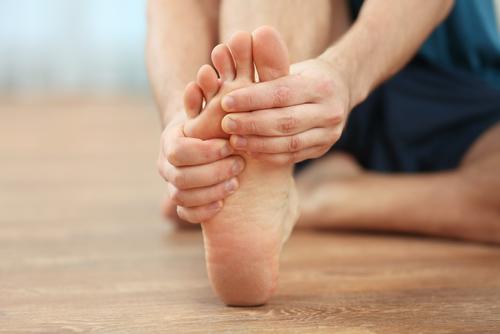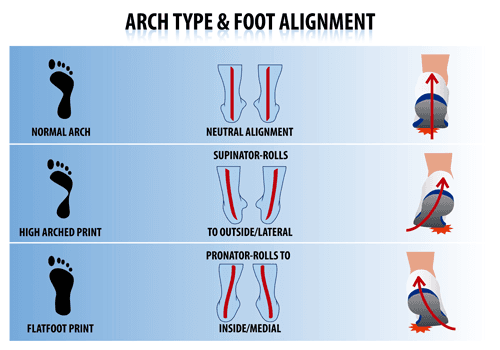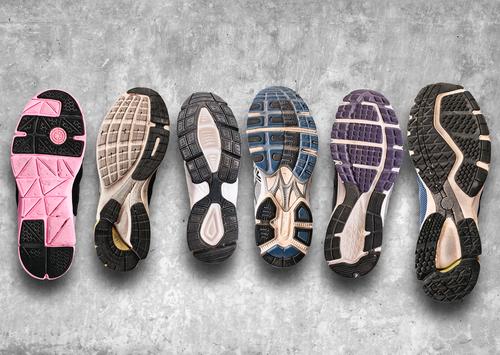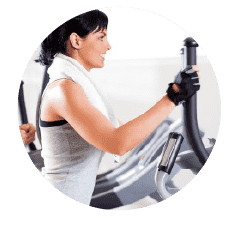How to Select the Best Footwear to Support Your Exercise of Choice
Be honest. When was the last time you went shoe shopping? No, not for a pair of heels or work boots, but for a pair of shoes you likely put on a few times a week – your workout shoes.
A person who engages in the recommended 150 minutes of moderate exercise or 75 minutes of vigorous exercise per week will spend anywhere from 3900 to 7800 minutes annually in athletic shoes. That amounts to anywhere from 65 to 130 hours per year. If you spend time running on trails or in the city, your shoe selection is even more critical due to the type of terrain you run on and potential for shock to your joints.
In this article, I will outline the importance of choosing the right shoe for the type of activity you do, choosing the right shoe for your feet, common foot problems, how to know when you need to buy a new pair of shoes, and where to buy your perfect pair.
Foot-Related Problems and their Causes
Many people suffer from foot-related pain, which can come in the form of plantar fasciitis, overpronation, weak ankles, heel spurs, muscle strain, hammertoes, bunions, and more (Silver, 2017). A study examined how foot problems affect older adults, and how wearing ill-fitting shoes and high heels can lead to foot pain (Menz & Morris, 2005). For the population of 176 adults age 62 to 96 years old, the researchers found that most participants wore shoes that are narrower than their feet. Women wore shoes that were not only narrower, but also shorter – and wearing this type of footwear is associated with corns, calluses, deformity, and foot pain. These findings indicate the need for people to correctly fit themselves for shoes and to manage and mitigate foot pain by avoiding high heels or shoes that are too tight (Menz & Morris, 2005).
For older adults especially, foot pain can increase the risk of falling and limit mobility. In addition to wearing high heels, foot pain is also associated with regular lifting during work activities (Dawson et al., 2002). Waking up in the morning with foot pain, foot pain upon standing, or foot pain before bed or that happens during certain exercises may signal that you should see a podiatrist.
If you have a dull or acute pain in the bottom of your heel or the lower part of the middle of your foot, you may have plantar fasciitis. This condition can happen for multiple reasons, including wearing the wrong type of shoe (with insufficient arch support), standing for long periods of time, running long distances, or weight gain (Silver, 2017).
Overpronation occurs when the arches of the feet roll inward or downward when a person walks. You may also know this condition by another more commonly-used term, flat feet. This can lead to injuries like shin splints, bunions, heel pain, plantar fasciitis, lower back pain, Achilles tendonitis, and inflammation (Fletcher, 2017). To combat this issue, people with flat feet can wear supportive shoes or orthotics and do exercises that strengthen the arches and muscles. I will talk more about what shoes to choose if you have flat feet in the next section.
Heel spurs are calcium deposits that result in a bony lump on the underside of the heel. Sometimes heel spurs are painless, whereas other times they can cause heel pain and are associated with plantar fasciitis. Some activities or behaviors are more associated with having heel spurs, like being overweight or obese, wearing ill-fitting shoes without sufficient arch support, running or jogging on hard surfaces, and having a gait abnormality (WebMD, 2019). Treatment for heel spurs includes physical therapy and exercises, as well as bracing.
Muscle strain may be a broader term and not necessarily associated with any one type of acute injury, but strains happen when participating in physical activities or from everyday activities. There are different types of strains, and they are rated from grade 1 to 3. Grade 1 strains refer to minimal stretching of fibers in the muscle or tendon, grade 2 is significant damage, and 3 is complete rupturing of fibers (Genesis Orthopedics & Sports Medicine, 2019).
Toes can also cause some issues and lead to foot pain. Hammertoes are when a toe has an abnormal bend in the middle joint, which can cause discomfort. For extreme cases, surgery may be needed to correct the issue. Bunions are another issue that can affect the toes, as a bony bump develops on the joint near the base of the big toe. Finally, calluses and corns are more innocuous issues, but can also be annoying and sometimes painful. Almost all of these issues described above can be prevented or improved by making smart footwear choices.
Finally, weak ankles can also cause pain by affecting your balance and increasing your risk of sustaining a sprain. Fortunately, there are exercises you can do at home to help strengthen your ankles. These include standing calf raises, standing on one foot, flexing then stretching your ankles, and circling them regularly. For a list of exercises and directions, click here (Santos-Longhurts, 2019).
“Protecting your feet and ankles during training is extremely important, because those are the most common injuries most people encounter,” said Drea Wheeler, Montreal-based Luxury Fitness Consultant and Fitness Expert. “Properly-fitted shoes are important because weightlifting shoes are not the same as cross training and running shoes. Meet with a trainer before starting your training regimen if you are unfamiliar with training methods and how your form should be when training. Lastly, always stretch after training,” Wheeler recommends.
Understanding What your Feet Need
Before you step foot into a shoe store or start browsing shoes online, you should first take some time to understand your needs. What type of activity do you do the most – running, cycling, weight lifting, cardio, walking, dancing, something else? There are even footwear considerations for lower-impact exercises like yoga. It is important to think about which activities you engage in the most, since it will have implications for the style and type of footwear you choose and can influence the price of the shoes.
“Recent studies have shown that a comfortable, proper fitting shoe can help keep you healthy. If you can stay healthy and get your runs in (as opposed to being injured) it should help your overall performance in the long run.” said Matt Norminton, Director of Purchasing and Logistics for Edmonton, Alberta-based running shoe and apparel retail company called the Running Room. “I would recommend going into your local run specialty store (hopefully the Running Room) to get a shoe fitting expert to help you select a comfortable shoe that will be a good fit for you.”
To get started, understanding the needs of your feet is an essential aspect of selecting an appropriate shoe. Start by examining the shape of your feet, looking specifically at the arches. You will be able to determine if you have high, neutral or low arches by standing on the floor and putting weight on both feet evenly. You can also figure out your arch height if you look at your footprint. If your arch almost touches the floor or if you can clearly see it defined in your footprint, you likely have low arches or flat feet. Conversely, if your arches don’t touch the floor or appear quite raised in your footprint, you probably have high arches.
Choosing footwear (or shoe insoles) with arch support is important for those who have high arches. You’ll want to look for a shoe with a deeper heel cup to accommodate your heels, rear foot support, and firm support (you should be able to push down on the arch, but it should not move too much).
If you have flat feet, you will want to choose a shoe or insole with a low but supportive arch that stabilizes your heel. It is not ideal to choose a soft and cushiony shoe or insole, because people with flat feet need structural support to prevent overpronation.
Finally, if you have weak ankles, you also need to be mindful of the type of shoes that you purchase for exercising purposes. How do you know if you have weak ankles? If they are frequently sore, or if you have experienced problems keeping your balance or your ankle twisting, you may have weak ankles.
Choosing Ideal Shoes based on Activity
The best shoe for you is one that allows you to do your favorite activities in a comfortable and supportive manner. Visiting a shoe store in person is the most ideal way to ensure you are purchasing athletic shoes that fit your feet, your needs and your budget. Big-box sporting stores and smaller specialty stores are good places to start when trying to purchase athletic shoes. Once you’ve identified which brand of shoes tends to work best for you, you can likely order those shoes online directly from the retailer or from the website of the store you purchased them from.
“What works for me or your brother or the speedy girl on the cover of Runner’s World may not be the ‘ideal’ shoe for you. We all have unique foot types and needs, so it’s important to go into your local specialty running store and speak to a shoe fitting expert,” Norminton advised. “Try on 3 or 4 pairs of shoes and if possible, take them for a spin on the treadmill. There shouldn’t be a break-in period, or you shouldn’t hope that they’ll feel better after a few runs – they should feel good on the foot right away.”
It is crucial to note that not all exercise shoes are not created equal. Which type of footwear you choose will depend on the type of activity you’re doing and the amount of support you’re seeking. For example, if you mostly engage in running, you’ll need a shoe specifically created for runners that has a lot of cushion and support to protect your joints against shock. Runners should select shoes that are created specifically for high-impact activities like running. Lighter shoes don’t have as much cushioning, so they may feel faster and more aerodynamic on your feet. However, if you are running long distances or your feet need cushion, you’ll want to probably choose a heavier, more supportive pair of shoes. Running shoes should also be flexible, which means they bend smoothly when your toes hit the ground to when your heels lift off the ground in one motion. Light, breathable shoes can help against sweat and stench (but may not be as supportive as a result). Finally, the “heel drop” is also important – or the difference in height from heel to forefoot.
Weightlifting, on the other hand, does not involve as much cardio and requires a totally different type of shoe. In fact, you should not use your running or general athletic shoes for lifting purposes. Running and general athletic shoes tend to be soft and cushiony, whereas the ideal lifting shoe should be hard with a raised heel. This comes in handy for exercises such as squats and deadlifts. You don’t need as much arch support when weightlifting, either. For these reasons, make sure to choose shoes specifically geared toward weightlifting activities. In addition, some weightlifters use Converse All Stars, which can be a good choice since they have hard soles and are durable as well as cost effective.
“A good shoe can make or break your workout routine and even decrease your chances for injury. Weightlifting shoes need to create a stable base for your feet, so any kind of flat soled shoes would work perfectly,” Wheeler recommended.
Another consideration is how often you should you replace your athletic shoes. Experts at the American Academy of Podiatric Sports Medicine say it depends on a few factors: the age of the shoe, amount of usage and signs of wear and tear (Furman, 2019). Generally, though, people can consider replacing worn out shoes after 300 to 500 miles of running or walking, 45 to 60 hours of cardiovascular activity like basketball, dance or tennis. If you notice any unevenness when you walk on a flat surface or any signs of noticeable creasing, those are also indicators that you should replace your shoes (Furman, 2019).
Keeping your Feet Happy
Taking care of your shoes is also important. Alternate your shoes each day and make sure to let your athletic shoes dry completely before wearing them again. Lingering sweat and moisture can contribute to fungal infections like athletes foot (LaBarge, 2016). Making sure to keep the skin of your feet moisturized, especially during winter or dry months, can also contribute to overall foot health. Dry skin can present in the form of cracked heels or peeling skin between the toes. Using a pumice stone on the heels can help slough off dry skin. Finally, getting a pedicure can also help with cracked heels and overgrown cuticles.
Stretching is also very important and can help you keep your feet and ankles in optimal shape.
“The best foot and ankle stretches are ankle circles, wall calf stretches, and Achilles stretch. Occasionally I would incorporate a band or a towel stretch to help your feet as well,” Wheeler added.
Other Accessories
Keeping your feet happy shouldn’t just involve shoe choice. Socks for low impact exercises like yoga and barre can also help protect your feet and make your workout more comfortable. Many barre studios require “sticky socks,” or socks that contain plastic grips on the bottom for greater traction and control during classes. Toe socks are another option
Toe separators can help provide relief to toes that are pushed together due to improper or tight footwear like heels, although their comforting effects are only temporary. However, toe separators are typically quite inexpensive and can be soothing to wear after a strenuous workout. You can even wear them to bed to help relax your toes and feet.
Conclusion
Choosing the right type of footwear to suit the needs of your foot or the kind of activity you are engaging in is an important and sometimes overlooked aspect of exercising. Fortunately, there are shoes available at various price points that can help you stay comfortable and take your fitness routine to the next level.
By Nicki Karimipour, PhD

Dr. Karimipour has previous experience in writing and editing for both print and online publications, and in teaching journalism, health writing, and public relations at the undergraduate and graduate level.
Her research-related experience ranges from collaborating with medical researchers and consulting on clinical trials, to clinical research program management. Her own research focuses on a variety of health topics, such as effects of social media use on female body image, football and concussions, and e-cigarette use among youth. Her research has been published in the Journal of Clinical and Translational Research, the Journal of Behavioral Health Services & Research, and the Journal of Sports Media.
She is based in Los Angeles, California and currently works at the University of Southern California in clinical trial operations. Follow her on Twitter: @NickiKPhD
References
Dawson, et al. (2002). The prevalence of foot problems in older women: A cause for concern. Journal of Public Health, 24(2), 77-84. Retrieved from https://academic.oup.com/jpubhealth/article/24/2/77/1578474
Furman, A. (2019). How do I know when it is time to replace my athletic shoes? Retrieved from https://www.aapsm.org/replace_shoes.html
Genesis Orthopedics (2019). Foot and ankle muscle strain. Retrieved from https://genesisortho.wpengine.com/patient-education/foot-and-ankle-overview/muscle-strain/
LaBarge, M. (2016). 10 tips for maintaining healthy feet. Retrieved from https://www.happyfeet.com/blog/maintain-healthy-feet/
Menz, H.B., & Morris, M.E. (2005). Footwear characteristics and foot problems in older people. Gerontology, 51, 346-351. Retrieved from https://www.karger.com/Article/PDF/86373
Santos-Longhurst, A. (2019). How to strengthen weak ankles. Retrieved from https://www.healthline.com/health/weak-ankles
Silver, N. (2017). Recognizing and treating common foot problems. Retrieved from https://www.healthline.com/health/foot-problems
WebMD (2019). Heel spurs and plantar fasciitis. Retrieved from https://www.webmd.com/pain-management/heel-spurs-pain-causes-symptoms-treatments#1






 Compact/Folding
Compact/Folding Front Drive
Front Drive Rear Drive
Rear Drive